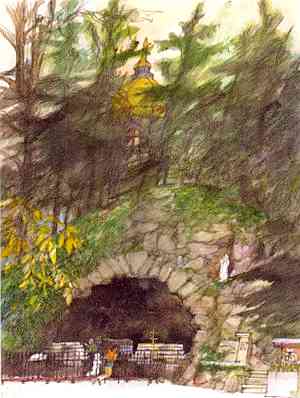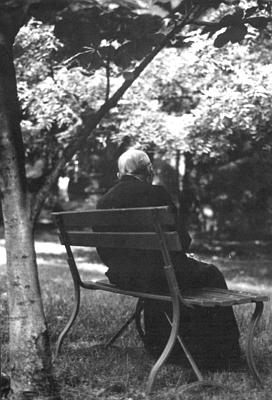
Notre Dame's Grotto / by Dorothy V. Corson


The Caretakers of the Grotto
Many caretakers have tended the Grotto over the past one hundred years. During the early 1980s, Franklin McMahon introduced the figure of Brother Roderic Grix, one of those many caretakers, in a painting he did of the Grotto.
Brother Rod began taking care of the Grotto in his twilight years when he was no longer able, due to a stroke, to carry on the constant repair work he did on campus. The Grotto painting which hung on a wall at the foot of his bed was admired by everyone who visited him. He always took pleasure in pointing to himself in it.
He said he had been tending the Grotto one day completely oblivious of the person who was painting it. He was about to leave after finishing his work when the artist asked his name and said he had painted him into the picture. He told him he would be getting prints made of the painting and he'd send him a copy.
He thought no more about it until one day he was surprised to find a large package had arrived for him. True to his word, McMahon had shipped him a 21" x 25" copy of the painting. It was beautifully framed and matted in green. Brother Roderic was in the middle of it, in his green and black lumberjack shirt, cleaning the wax off the candle holders. He never knew the painter, Franklin McMahon, was a well known artist who had also sketched many buildings on campus. His Grotto painting became a source of inspiration to many people in the years it hung at the foot of his bed. Brother Roderic died in the mid 1980s. His lovely watercolor of the Grotto now decorates the living room wall of a dear friend, Mary Grix, who loves it as dearly as he did.
In the one hundred years the Grotto has enriched the campus there must have been an endless parade of unsung caretakers. Sweeping away the gathering leaves in the fall, cleaning the wax from the candle holders, replenishing its candles and lovingly caring for it.
Brother Roderic was only one of those many caretakers. After his stroke, his work at the Grotto was taken over by Brother Protase Bauer who tended the Grotto with his own special brand of devotion. He would bring the large glass candle containers back to Holy Cross House when the candles burned out. He had a large industrial bucket with sand in it, in which he had placed a light bulb on an extension cord. He used this method to melt the left over wax in the containers. He would then transfer the melted wax to a freshly washed candle holder and place a new wick in it. In this way, he recycled the used candle containers that, before that time, were thrown away. Later, he added an extra touch to them by having someone paint violets on the glass containers. Brother Protase was a quiet, kindly little man always friendly and solicitous to everyone he encountered.
He had a fondness for bright, sunny daffodils. When he found them in the woods in excess, he would divide them and plant them somewhere else to bring cheer to anyone passing by on the campus
Another Brother who spent hours at the Grotto was Brother Cosmas Guttly. Corby Hall, adjacent to the Grotto area, was home to him for many years. A large screened-in porch overlooks a small court yard of greenery. It also overlooks the Grotto lawn, its park benches scattered among the trees. A constant parade of people pass by going to and coming from the Grotto.
 Brother Cosmas was often seen tidying up the Grotto, resting, talking to people, and tending the flower beds there and around Corby Hall. Alice Osberger, a secretary on campus, was walking toward the Grotto on a lunch break one day when she saw Brother Cosmas hunched over a flower bed near Corby Hall. She thought he was ill and went to help him. She said when she got closer to him she realized that he was weeding it.
Brother Cosmas was often seen tidying up the Grotto, resting, talking to people, and tending the flower beds there and around Corby Hall. Alice Osberger, a secretary on campus, was walking toward the Grotto on a lunch break one day when she saw Brother Cosmas hunched over a flower bed near Corby Hall. She thought he was ill and went to help him. She said when she got closer to him she realized that he was weeding it.
He also helped in the the church and sacristy. For years this quaint, frail little man, with the round wire-rimmed glasses and skirted black cassock, was a familiar sight to many as he quietly served the priests during Mass at Sacred Heart Church. He was revered by priests and lay people alike as a very holy man.
In between church services, and his other work, he was always at the Grotto. One day a week he would go to Holy Cross House, the retirement home for priests on the campus. There he would help his "good buddy," Brother Edward, attend the infirm priests who said their daily Mass in the long corridor of sit-down altars for use by priests in wheelchairs. Then he would return to the Sacred Heart Church in time for the 5 o'clock service.
Brother Cosmas came from Switzerland. He was a businessman before he became a Brother in mid life, after the death of his wife and child in childbirth. He was gifted in many ways. His daily devotion to the Grotto and its surroundings, was captured in a unique, unidentified, full page photograph of him in the back of the 1990 Dome. He was sitting alone on a secluded park bench, dressed in his black cassock, head bowed, meditating or praying a little distance from the Grotto.
With his back to the camera he could not have known the picture was being taken. Only those who knew Brother Cosmas well would have known it was him. Very soon after the picture was taken he was confined, by his infirmities, to Holy Cross House. He died there two months after his 99th birthday.
Herbie De Mike, an employee of the University, has taken care of the Grotto now for a number of years.
If your guest should be non-Catholic,
to make her feel at ease
introduce her to the Grotto first:
That's probably where you'll go first anyway.
Notre Dame Religious Bulletin
October 14, 1941